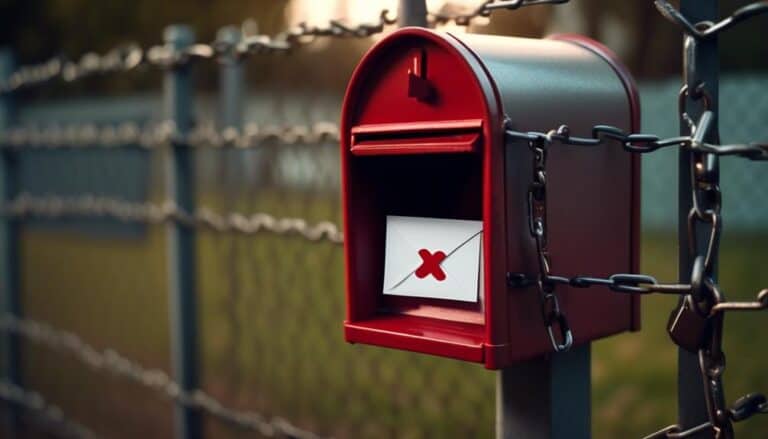Stay Ahead of the Curve: Mastering Compliance in Your Email Strategies
In the ever-evolving landscape of email marketing, staying ahead of the curve is like navigating a winding river with ever-changing currents. You must adapt and master compliance in your strategies to ensure your messages reach your audience effectively and legally.
But where do you begin? How can you navigate the complex web of regulations while still achieving your marketing goals?
In this discussion, we will guide you through the intricacies of email compliance, providing you with valuable insights and practical tips to help you stay on top of your game.
So, buckle up and get ready to discover the secrets to mastering compliance in your email strategies.
Key Takeaways
- Regularly clean email lists, monitor sending reputation, and engage recipients with relevant content to maintain high email deliverability rates.
- Implement email authentication protocols like SPF, DKIM, and DMARC to enhance the trustworthiness of emails and prevent fraud and spoofing.
- Obtain explicit consent from subscribers through an opt-in process and keep records of consent documentation as proof of compliance.
- Establish a streamlined and user-friendly unsubscribe process, including a clear and visible unsubscribe link, honoring opt-out requests promptly, and offering alternative communication channels.
Understanding Email Compliance

Understanding email compliance is crucial for ensuring that your email strategies align with legal and regulatory requirements. Two key aspects of email compliance that you need to be familiar with are email deliverability and email authentication.
Email deliverability refers to the ability of your emails to reach the intended recipients' inboxes. It's influenced by various factors, such as the quality of your email list, the reputation of your sending IP address, and the engagement of your recipients. To maintain high deliverability rates, it's important to regularly clean your email list, monitor your sending reputation, and engage with your recipients through relevant and valuable content.
Email authentication, on the other hand, focuses on verifying the authenticity of your emails. It helps prevent email fraud and spoofing, which can damage your brand reputation and compromise the security of your recipients. Implementing email authentication protocols, such as SPF (Sender Policy Framework), DKIM (DomainKeys Identified Mail), and DMARC (Domain-based Message Authentication, Reporting, and Conformance), can significantly enhance the trustworthiness of your emails.
Legal Requirements for Email Marketing
To ensure compliance with legal requirements, it's important for email marketers to adhere to specific guidelines and regulations. When it comes to email marketing, obtaining consent from recipients is crucial. Consent documentation should be obtained in a clear and explicit manner, ensuring that individuals have willingly provided their permission to receive emails from your organization. It's essential to keep records of this consent documentation for future reference, as proof of compliance.
In addition to consent documentation, email content guidelines must also be followed. These guidelines ensure that your emails aren't only compliant but also respectful and valuable to your recipients. It's important to avoid misleading subject lines, deceptive content, or spam-like practices. Your emails should clearly identify the sender and provide an easy way for recipients to opt-out or unsubscribe from future communications.
Building a Solid Email Permission Strategy

Developing a strong email permission strategy is essential for ensuring compliance and building a successful email marketing campaign. One of the key factors in email marketing is email deliverability, which refers to the ability of your emails to reach the recipients' inboxes. If your emails aren't delivered, your entire email marketing efforts will be in vain.
To improve email deliverability, it's crucial to obtain explicit permission from your subscribers before sending them any emails. This can be done through an opt-in process, where subscribers voluntarily provide their email addresses and give consent to receive emails from your business.
In addition to obtaining permission, managing email bounces is another important aspect of building a solid email permission strategy. Email bounces occur when your emails aren't delivered to the intended recipients due to various reasons, such as invalid email addresses or full mailboxes.
Ensuring Opt-Out and Unsubscribe Compliance
When it comes to ensuring opt-out and unsubscribe compliance in your email strategies, there are two key points to consider.
First, you must meet the opt-out requirements set by regulations, such as providing a clear and easy way for recipients to unsubscribe from your emails.
Second, you need to establish a streamlined and user-friendly unsubscribe process that allows recipients to easily opt out without any hassle.
Opt-Out Requirements
Ensure compliance with opt-out and unsubscribe requirements by providing clear and accessible options for individuals to easily opt out of receiving future email communications. When it comes to opt-out best practices, managing email preferences is crucial to maintaining a positive relationship with your audience. By implementing a user-friendly opt-out process, you not only demonstrate respect for your recipients' preferences but also maintain compliance with regulations such as the CAN-SPAM Act.
To ensure your opt-out process is effective, consider the following:
| Opt-Out Best Practices |
|---|
| Provide a clear and visible unsubscribe link in all email communications |
| Honor opt-out requests promptly to avoid potential legal issues |
| Offer alternative communication channels for recipients who wish to stay connected |
| Regularly update your email preferences center to allow recipients to customize their communication preferences |
Unsubscribe Process
To maintain compliance with opt-out requirements and ensure a seamless unsubscribe process, it's crucial to implement an efficient and user-friendly system for managing email preferences. This not only improves the user experience but also helps in reducing the unsubscribe rate.
Here are three key steps to achieving this:
- Clear and Visible Unsubscribe Link: Make sure the unsubscribe link is easily visible in your email campaigns. Use a larger font size and contrasting color to ensure it stands out. This will enable recipients to find and click on it without difficulty.
- One-Click Unsubscribe: Streamline the unsubscribe process by enabling a one-click option. Avoid requiring users to log in or provide additional information. Simplifying the process will increase user satisfaction and reduce frustration.
- Prompt Confirmation: After a user unsubscribes, promptly confirm their opt-out status. This assures them that their request has been successfully processed and gives them peace of mind.
Implementing Data Protection Measures

Now it's time to focus on implementing data protection measures in your email strategies.
To ensure privacy policy compliance, you need to clearly outline how you handle and protect customer data.
Implement encryption and security measures to safeguard sensitive information from unauthorized access.
Additionally, obtain explicit consent from subscribers and provide an easy opt-out process to respect their preferences and rights.
Privacy Policy Compliance
Implementing data protection measures for privacy policy compliance is essential for maintaining trust with your customers and ensuring regulatory compliance. To effectively address privacy concerns and protect sensitive customer information, consider the following measures:
- Data breach prevention: Implement robust security measures such as encryption, firewalls, and secure data storage to minimize the risk of data breaches. Regularly monitor and update security protocols to stay ahead of emerging threats.
- Data retention policies: Define clear guidelines on how long customer data will be retained. Ensure that you only retain data for as long as necessary and securely dispose of it once it's no longer needed. This helps avoid potential privacy breaches and ensures compliance with data protection regulations.
- Transparency and consent: Obtain explicit consent from customers before collecting or using their personal information. Clearly communicate your privacy policies, including how data will be used, shared, and stored. Regularly review and update your privacy policy to align with evolving regulations and customer expectations.
Encryption and Security
You can enhance the security of your email strategies by implementing strong encryption and data protection measures.
With the increasing prevalence of data breaches, it's crucial to ensure secure communication and protect sensitive information.
Implementing encryption technology helps safeguard your emails from unauthorized access, ensuring that only the intended recipients can read the content. Encryption works by converting the message into a coded form, making it unreadable to anyone without the decryption key.
Additionally, you can implement data protection measures such as two-factor authentication, regular security audits, and employee training on email security best practices.
Consent and Opt-Outs
To ensure compliance and protect sensitive information in your email strategies, it's essential to implement effective measures for obtaining consent and providing opt-outs. By properly managing email preferences and consent, you can build trust with your subscribers and maintain compliance with data protection regulations.
Here are three key steps to consider in implementing consent management:
- Obtain explicit consent: Clearly explain the purpose and scope of your email communications and obtain explicit consent from your subscribers. This can be done through a double opt-in process or by providing a clear checkbox for users to actively opt-in.
- Provide easy opt-out options: Make it simple for subscribers to opt-out of your emails. Include an unsubscribe link in every email and ensure that the process is straightforward and hassle-free.
- Respect preferences: Regularly review and update your subscribers' preferences. Allow them to easily manage their email preferences, such as frequency of emails or specific topics of interest.
Staying Updated With Email Compliance Regulations

Staying updated with email compliance regulations is crucial for ensuring the legal and ethical handling of email communications. With the ever-evolving digital landscape, it's important to stay informed about the latest requirements and guidelines to avoid potential legal issues and maintain a positive reputation.
Email compliance challenges can arise due to various factors such as privacy concerns, data protection laws, and industry-specific regulations. In order to navigate these challenges effectively, it's essential to implement best practices for email compliance.
One of the key best practices is obtaining proper consent from recipients before sending any commercial emails. This can be done through explicit opt-ins or double opt-ins, where individuals explicitly confirm their consent to receive emails. Additionally, providing clear and easy-to-find opt-out options is crucial to respect the recipients' choices and preferences.
Regularly reviewing and updating your email compliance policies and practices is also essential. This includes keeping track of changes in relevant regulations, industry guidelines, and best practices. By staying proactive and up-to-date, you can ensure that your email communications align with the latest compliance requirements and maintain a strong compliance program.
Frequently Asked Questions
What Are the Potential Consequences for Non-Compliance With Email Marketing Regulations?
You could face potential consequences and legal ramifications if you don't comply with email marketing regulations. It's important to stay informed and follow the rules to avoid any negative outcomes.
Are There Any Specific Regulations or Laws That Apply to Email Marketing for Different Countries?
There are specific regulations and laws that apply to email marketing in different countries. It's important to be aware of international email marketing regulations and consider key factors for global email campaigns.
How Can I Ensure That My Email Permission Strategy Is Effective in Gaining Consent From Subscribers?
To ensure consent effectiveness and improve subscriber engagement, focus on clear and concise communication. Use compelling content and personalized messaging to engage subscribers and make it easy for them to give consent.
What Steps Should I Take to Handle Opt-Out and Unsubscribe Requests in a Compliant Manner?
To handle opt-out and unsubscribe requests in a compliant manner, make sure to promptly process these requests and remove the individuals from your email list. Comply with privacy regulations by providing clear instructions for opting out and honoring these requests.
Are There Any Best Practices for Implementing Data Protection Measures to Safeguard Email Subscriber Information?
To safeguard your email subscriber information, implement data encryption to protect sensitive data. Regularly update your privacy policy to include any changes in data protection measures, ensuring compliance with regulations.
Conclusion
To stay ahead of the curve and master compliance in your email strategies, it's crucial to understand email compliance regulations and legal requirements for email marketing.
Building a solid email permission strategy, ensuring opt-out and unsubscribe compliance, and implementing data protection measures are essential steps to maintain compliance.
In this ever-changing landscape, staying updated with email compliance regulations is key to safeguarding your email marketing efforts and preserving a positive reputation.








